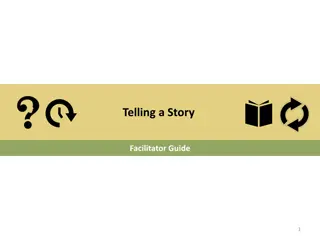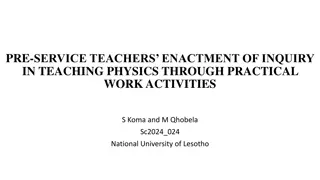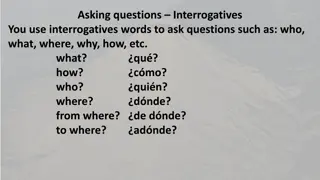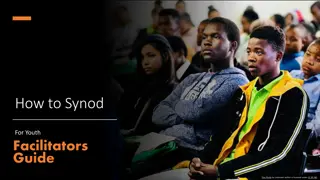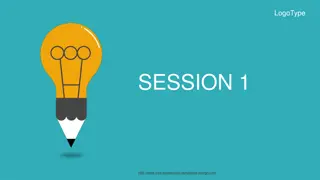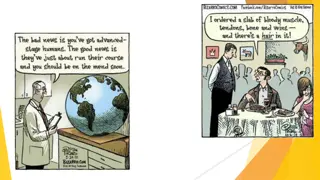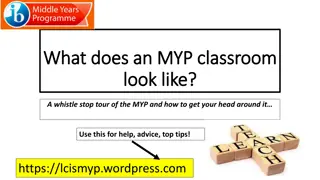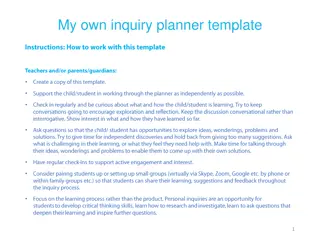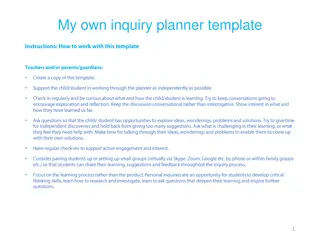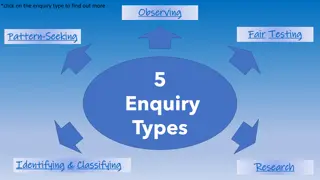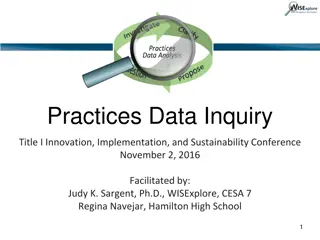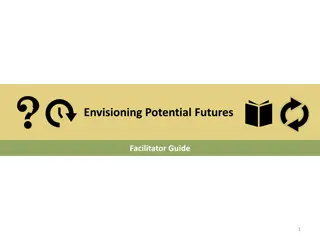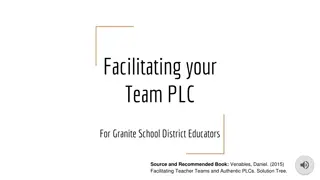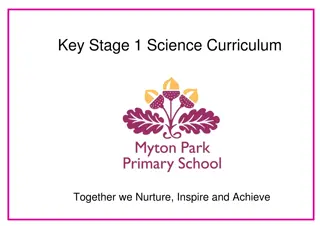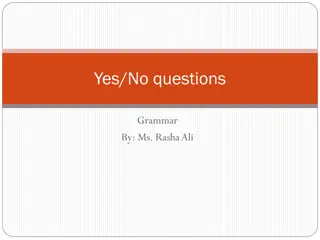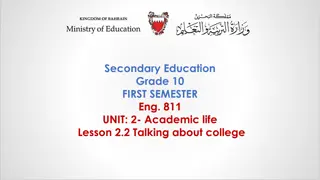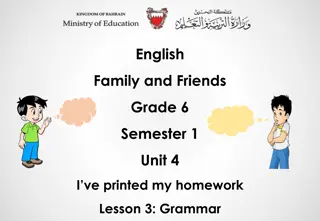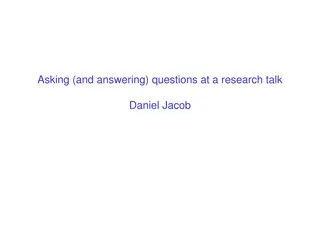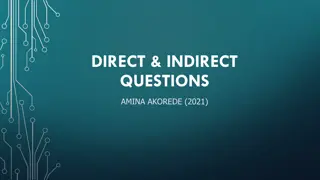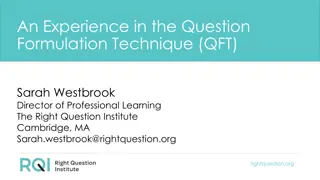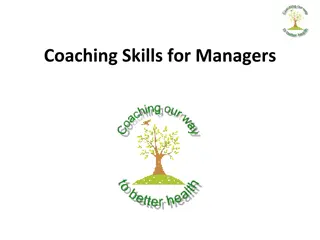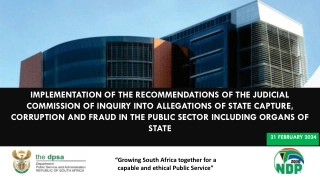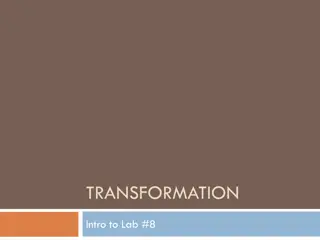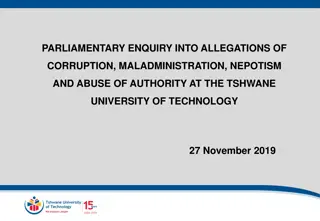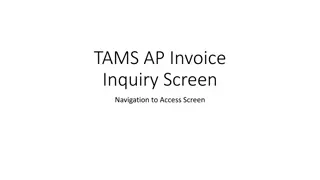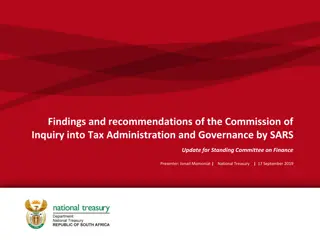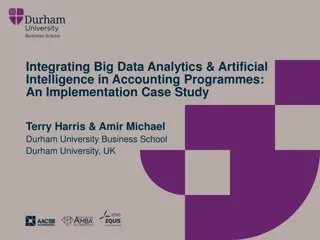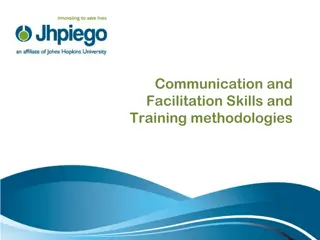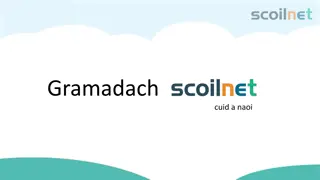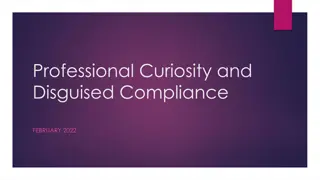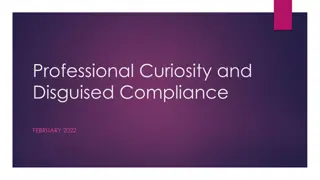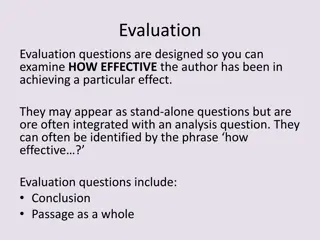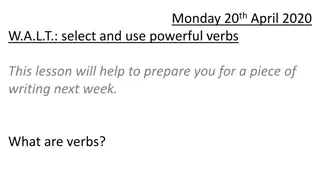Enhancing Inquiry Skills: Asking Powerful Questions Facilitator Guide
This guide facilitates an exercise focusing on inquiry and generating powerful questions to enhance strategic thinking. It involves participants in questioning assumptions, exploring diverse perspectives, and planning information-seeking activities. Through group discussions and reflection, participants develop a deeper understanding of complex situations. The exercise aims to improve question-generation skills, promote comprehensive learning, and encourage reflection on different question types.
Download Presentation

Please find below an Image/Link to download the presentation.
The content on the website is provided AS IS for your information and personal use only. It may not be sold, licensed, or shared on other websites without obtaining consent from the author. Download presentation by click this link. If you encounter any issues during the download, it is possible that the publisher has removed the file from their server.
E N D
Presentation Transcript
Asking Powerful Questions Facilitator Guide 1
Asking Powerful Questions Facilitator Guide Purpose of Exercise This exercise provides practice in inquiry and asking powerful questions. Asking insightful questions promotes comprehensive information gathering and learning. Both are foundational to strategic thinking. This exercise also provides practice in generating ideas for how and where to seek answers to questions in order to understand a complex situation more fully. Estimated Run Time This exercise will take approximately 4-1/4 hours. To reduce the length of the exercise, certain portions of the exercise can be conducted as homework or on one s own time. Summary of Exercise Using a photo image and brief description of a situation, participants: Generate a set of questions about the situation depicted in the image. Work in small groups to organize, categorize, and label the questions. Develop a plan for where and how to seek information to address the questions and develop a better understanding of the situation depicted in the image. Work together as a group to reflect on and discuss the exercise. 2
Asking Powerful Questions Facilitator Guide Learning Objectives By the end of this exercise, participants should be able to: Generate a wider variety of questions to support learning and situational understanding, question assumptions, and explore alternative perspectives. Recognize characteristics of different types of questions: descriptive, explanatory, and exploratory questions and questions that test fundamental assumptions. Appreciate the kinds of information that can be gained from different types of questions. Develop ideas for diverse information-gathering activities needed to answer a wide- ranging set of questions. Recognize characteristics of powerful questions. Relation to Other Exercises This exercise is used best after participants have completed Reflecting on the Environment and before Telling a Story and Envisioning Potential Futures. Group or Individual Activity This exercise includes activities that require a combination of both group and individual work. 3
Asking Powerful Questions Facilitator Guide Materials Needed (facilitator) Images with brief descriptions (Included in the exercise materials) One copy per participant Within small group, each individual gets copy of same image Each small group gets different image Whiteboard, markers Post-it notes Approximately 30/participant For legibility, need to be at least 3 x 5 in size Room with sufficient wall space to post large sets of post-it notes One Participant Guide for each participant Expert perspective videos (viewable in the Managing Complex Problems Resource: Expert Perspective Videos page, filter by Asking Powerful Questions) Materials Needed (participants) Participant Guide Pen/pencil Notebook 4
Asking Powerful Questions Facilitator Guide Facilitator Tips and Guidance Be aware that any image has the potential to trigger PTSD . Consider this if you decide to select your own images. If you see indications that a participant is experiencing a PTSD response, stop the exercise and address the situation. Remind participants there is no right answer. The point of the exercise is not to correctly identify the image, but to learn how to generate useful questions and seek information. Quality of questions matters more than quantity. Emphasize the importance of getting beyond what and how questions. Emphasize the value of why, what if, and how could questions for gaining deeper insight. Intersperse the pre-, mid-, and post-exercise reflection discussions with videos on the topic of questioning (viewable in the Managing Complex Problems Resource) 5
Asking Powerful Questions Facilitator Script Instructions The next several pages provide step-by-step instructions for facilitating the exercise, broken down into modules. Each module includes icons to indicate its duration, DO: facilitator actions, SAY: facilitator talking points, and DISCUSS: questions for group discussion (see below for icons). While the talking points are simply intended to guide the facilitator, we recommend including them to achieve the intended learning outcomes. Talking points that are listed directly under an action are meant to assist the facilitator with that given action. Also, optional break points are indicated at the end of certain modules. Some modules also include clickable links to the exercise slide deck that supplement the facilitator guide. We recommend referring to the accompanying slide content while guiding your group through this exercise. Module SAY DISCUSS DO Duration 6
Step Facilitator Activity 1 DO - - Exercise Set up Distribute and describe the Participant Guide. Give each participant a marker and set of post-it notes. 30 min SAY - Today we are going to practice our questioning skills, as well as our skills in seeking information to answer questions. This guide contains information you will use throughout the exercise. I ll let you know when you need to turn to a particular section. Also, you can take this with you after the exercise. - DO - Conduct pre-exercise reflection. Direct participants to the Participant Guide and describe the task. SAY - Before we get started, please flip to the Pre-Exercise Reflection section of your Participant Guide. Take a few minutes to think about the questions listed there before we discuss them as a group. DO - View Value of Asking Powerful Questions Exercise and sampling of other expert perspective videos on questioning. Access through the Managing Complex Problems Resource: Expert Perspective Videos page, filter by Asking Powerful Questions. 8
Step Facilitator Activity 1 Exercise Set up (contd.) DISCUSS - Guide the group through a discussion using the questions for group discussion below: - What do you think makes a useful question? - Why is it important to ask questions? - Are some questions better than others? In what ways? - Thinking about questions you might ask that are about tactical or operational issues, compared to questions you might ask at a strategic level - How would you describe the differences in the types of questions? - What sort of information are they likely to elicit? 30 min DO - - Provide brief tutorial. See supporting slides. [Note: Facilitator may decide to present tutorial verbally, print the slides, project PowerPoint, or some combination thereof.] 9
Step Facilitator Activity 1 Exercise Set up (contd.) DO - Describe the exercise. SAY - - 30 min The task involves working with images. To practice the skill of questioning, we are going to work with an image [hold up some examples]. I will give you one in a minute. In this first segment, you will work individually. Your task is to take some time to examine the image I give you. Then spend 10-15 minutes generating questions about the situation or event represented by the image. Write each of your questions on a post-it note. - - [End of Step 1] 10
Step Facilitator Activity 2 Participants Generate Questions DO Ask participants to form small groups; the groups will work together later in the exercise. [Note: They can self-form the groups, or you can count off to determine group membership.] Refer participants to the Question Generation page in their Participant Guide. 25 min - SAY - The Question Generation aid provides information that will help you think about the image and develop a variety of questions. DO - Distribute images (Each person within a small group should have his or her own copy of the same image. Each group should have a different image.). SAY - Spend 15-20 minutes working individually; examine the image and generate questions about the situation or event represented in the image. 11
Step Facilitator Activity 2 Participants Generate Questions (contd.) SAY Think about: What do you want to know about the image that will help you understand the situation/event that it represents? What are the questions we would need to ask and answer to understand the problems or circumstances reflected in this picture? Use the post it notes to record your questions as you think of them. Use a separate post-it for each question. 25 min [End of Step 2] 12
Step Facilitator Activity 3 Mid-Exercise Reflection DO Refer participants to the Mid-Exercise Reflection page in their Participant Guide and ask them to work individually. View The questions an expert would ask videos. Access through the Managing Complex Problems Resource: Expert Perspective Videos page, filter by Asking Powerful Questions. 10 min SAY - Think about the questions posed in your guide. For example: What are you finding challenging about generating questions? Jot down your responses to the reflection questions. Let s take a look at how a couple of experts approached this activity. - - [End of Step 3] - BREAK - 13
Step Facilitator Activity 4 Question Review DO Post each of the images that groups have been working with on the wall. Leave working space between the images. 45 min SAY - What we are going to do now is take a step back and look at all the questions we ve come up with about each of these images and the situations they represent. DO - Ask participants to place their post-its on the wall next to the image they worked with. SAY - Gather all your post-it notes and put them up on the wall around the image you have been working with. 14
Step Facilitator Activity 4 Question Review (contd.) DO - Ask participants to review images and questions on wall. SAY - Take 5-10 minutes to walk around and take a look at each image and the questions posted about each image. Think about the nature of the questions. How are the questions similar? Different? 45 min DO - Refer participants to Question Review in their Participant Guide. SAY - Now we re going to spend some time talking about the collection of questions in more detail what s here, what isn t, and what that means for understanding the situations represented in the images. After we spend some time working with these details, we ll take a step back and see if we can identify a bigger picture. 15
Step Facilitator Activity 4 Question Review (contd.) DO - Have participants use the Question Review aid to review post- it questions. Facilitate group discussion using the Question Review aid. Point out some of the questions that stand out for you. - - 45 min SAY What are some of the most common questions? Which questions: Consider future implications? Consider relationships or interactions? Test assumptions? Reveal paradoxes? Consider hypotheticals? Are there any questions that surprise you? Which questions do you think are the most useful/critical to your understanding of the problem? Why? Are there gaps? [End of Step 4] 16
Step Facilitator Activity 5 Clustering & Synthesis SAY We are now going to do a clustering and synthesis activity. Get together with your small group, and gather around the image that you generated questions for. 20 min DO - Have participants gather in their small groups to cluster the questions associated with their image. SAY Group the questions based on similarity. Move the post-its around and talk about what goes where and why. There is no right or wrong way to group the questions. There are likely multiple ways to do it. Let me know once your small group is in agreement about the clusters. DO - Ask the group to work together to develop a descriptive label for each of the clusters of questions. 17
Step Facilitator Activity 5 Clustering & Synthesis (contd.) DO - Ask the group to work together to develop a descriptive label for each of the clusters of questions. SAY - 20 min Now that you have grouped the questions, work together to come up with a descriptive label for each cluster. The label can be a word or brief phrase that describes the types of questions in that cluster. What we are doing is creating a set of categories that represent the major dimensions of inquiry about the situation represented in each image. - - DO - Have each group review the other groups clusters and labels. SAY - Now spend a few minutes reviewing the clusters and categories developed by the other small groups about their images. 18
Step Facilitator Activity 5 Clustering & Synthesis (contd.) SAY - As you do this, consider: - How are the question types similar to the questions you developed? How are they different? - What was challenging about this portion of the exercise? - In what ways do you find yourself thinking about the situation in the image differently now than at the start? 20 min [End of Step 5] 19
Step Facilitator Activity 6 Reflection & Debrief DO - Refer participants to the Reflection and Debrief section of the Participant Guide. 15 min DISCUSS - Guide the group through a discussion using the following questions: - What have you learned from this activity? What are your big take-aways? - How has this activity helped you identify questions you would not have otherwise asked? - Think about the questions you identified earlier as your three best/most useful questions. Do you still see them that way? Why/why not? - What have you learned about how to ask questions that will help you gain a deeper understanding of situations or problems? - How can you use what you learned so far in your work? [End of Phase 1] - BREAK - 20
PHASE 2: INFORMATION-GATHERING Note: Depending on time available, Phase 2 ( Planning for Information-Gathering ) could be included as an activity in Phase 1: Step 6, but a break will be necessary. 21
Step Facilitator Activity 1 Idea Generation DO - - Provide brief tutorial. See supporting slides. [Note: You can give the tutorial verbally, print it out for participants, project the content in PowerPoint, or some combination thereof.] 30 min SAY - We have come up with plenty of questions about the images. Now we are going to generate ideas for how to find answers to those questions. DO - Have participants return to the small groups they worked with in Phase 1 of the exercise. SAY - Each group is going to work with the set of questions generated for the image you worked with before. Take a few minutes to review the questions you came up with about the image. - 22
Step Facilitator Activity 1 Idea Generation (contd.) DO - Assign categories to individuals, using the categories the group generated in Phase 1. Refer each small group to the categories of questions identified for their image in Phase 1, Step 5. - 30 min SAY - After you ve reviewed all the questions and categories you came up with, each person in the group should choose one or two categories to work with for this part of the exercise. DO - Refer participants to Planning for Information Gathering questions in their Participant Guide. Have participants generate information-gathering ideas. Ask them to consider wild ideas for information searching, so they do not just name the usual sources. - - 23
Step Facilitator Activity 1 Idea Generation (contd.) SAY - Once everyone in your group has one or two categories of questions to work with, your task is to work individually to review the set of questions contained in your assigned categories. Spend 10-15 minutes thinking about how and where you would seek answers to those questions. Use the Planning for Information Gathering worksheet to help you with this activity. Jot down your ideas so you can share them later on. 30 min - - - [End of Step 1] 24
Step Facilitator Activity 2 Small Group Discussion DO - Refer participants to Small Group Discussion in the Participant Guide. As a group, have them discuss questions posed in the Participant Guide. - 20 min SAY - We re now going to share and discuss the ideas you generated with your small group. We re going to share these ideas later in the larger group, so keep track of the ideas your group generates. - [End of Step 2] 25
Step Facilitator Activity 3 Present Info- Gathering Plans DO - Ask each small group to designate a spokesperson. SAY - One member of your group is going to present your group s ideas to the rest of us. So choose a spokesperson and spend a few minutes pulling together the ideas your spokesperson will share. Your presentation should include both the categories of questions you were working with and the ideas for seeking answers you came up with, along with any other ideas you want to share. 30 min - DO - Select a group to go first. Have each spokesperson present their group s info-seeking plan to the larger group. Encourage others to ask questions and build upon one another s ideas. - [End of Step 3] 26
Step Facilitator Activity 4 Final Reflection & Debrief DO - Direct participants to the Final Reflection in the Participant Guide and describe the task. Ask participants to work on their own and consider the questions listed in the Participant Guide. - 15-20 min SAY - We are now going to spend time thinking about what we have done in this exercise. First, spend 5-10 minutes thinking about the questions posed in the Final Reflection part of your guide. Jot down some notes in response to the questions. - DISCUSS - Guide the group through a discussion using the following questions: - What was difficult about coming up with ideas about how to find answers to your questions? What made it difficult? - What information sources or information seeking methods did others mention that you had not thought of? Which suggestions gave you new ideas about how you might gather information to answer the questions? 27
Step Facilitator Activity 4 Final Reflection & Debrief (contd.) DISCUSS [Questions contd.] - Which types of questions are fairly easily addressed, and which are harder to figure out where or how to get information to address them? - If we hadn t done what we did in Phase 1, generating all the questions, how might your search for information have been different? What might you have missed? - Think for a moment about both phases of this exercise (i.e. generating questions and developing a plan to answer them). What have you learned? How might you apply what you learned to your current role? Or to future roles? 15-20 min [End of Questioning to Deepen Learning Exercise] 28


